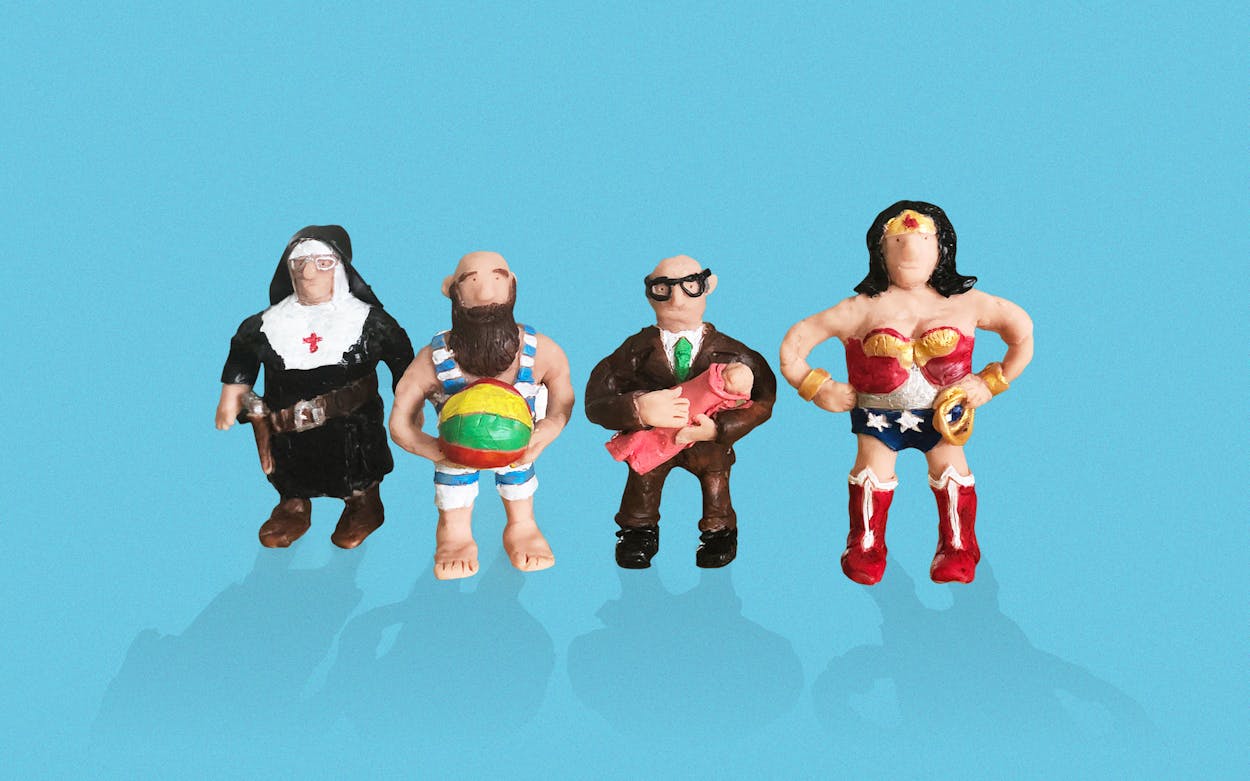I didn’t realize, until I embarked on a pandemic hobby, how satisfying it is to be bad at something and not care at all. The art form in which I aspire to be less than mediocre is sculpture, though I should probably put that word inside quotation marks to avoid outraging artists who have consecrated their lives to mastering a craft to which I am such a frivolous newcomer. Their presumptive contempt is noted and embraced.
I had long thought I needed a hobby to liberate me a bit from the creative claustrophobia that had ensnared me as an all-day-every-day writer. The problem was that most of those hobbies—playing the harmonica, say—required some degree of learning and commitment before they could be any fun, and I had enough rigor with my day job. I needed something that was soothingly distracting from the start, that was as low-stakes as possible, and that could be done while half-watching Netflix. I also wanted something tangible to come out of my efforts, not a hard-won but short-lived musical note from the harmonica. I liked the idea of a result I could hold in my hands and whose weight I could feel.
And so I came to Super Sculpey. For someone like me who has a childish fondness for plastic surfaces and for bright primary colors, this product was a classic case of artist-meets-medium. Super Sculpey is only one brand name of polymer clay, a substance that contains no clay at all but instead is a PVC resin mixed with a liquid plasticizer. It’s considerably more resistant than Play-Doh, but still elastic enough to mold, and unlike Play-Doh, when you bake it in the oven it turns into a hard plastic that I trust will last throughout the ages. The toxic-sounding ingredients of polymer clay can, if you get distracted and let your masterpiece burn in the oven, release a bit of hydrogen chloride gas. But so far I haven’t had any Madame Curie mishaps.
You can buy polymer clay in colors, or you can get a neutral shade like Super Sculpey and paint it either before or after baking. What I like about Super Sculpey is its default beige flesh tone, which is sort of waxy and almost translucent. For that reason it’s a favorite of dollmakers and is particularly suitable for homunculi makers like me.
Yes, it is the human form that calls to me. Or whatever version of the human form I can approximate without trying too hard. So far during the pandemic I’ve done ten of them. They include an old man who looks like the late talent agent Swifty Lazar holding a baby, a one-eyed man with a crewcut and a mustache hefting a trophy, a nun reaching for a six-shooter, and Wonder Woman.
What is driving all this? I have no idea. I’m a tightly wound and deliberate writer who has never warmed up to the widely accepted precept of producing a sloppy first draft direct from the unconscious mind. But I’m nobody’s idea of a fussbudget when it comes to sculpture. I start out with a stiff wad of Super Sculpey, feed it through this pasta-machine thing that makes it malleable, and start to pack it around a stick-figure armature made of wire and aluminum foil. Then whatever happens, happens. There’s no thinking involved, and no worry that the final product won’t be any good—because it won’t be any good.
It’s not that I’m completely uneducated. I’ve googled “polymer clay” and watched a half-dozen videos by masters of the art who have patiently walked me through the process of producing realistic figures of fairies, wide-eyed babies, and comic book villains. Their patience and craftsmanship impressed me, and provided some needed advice, but it also had the curious effect of confirming my initial instinct that I didn’t want to improve. If I tried harder and grew meticulous and demanding of myself, the result would only be a pathetic attempt to measure up to mediocrity.
Knowing that I had zero talent freed me from the looming concerns that haunt me every waking moment as a writer: find the right word, construct the tightest sentence, bring the thought home. As a sculptor, I just don’t care. My little humanoids have globs for hands and pinpricks for eyes. After they’ve baked in the oven like surreal gingerbread men, I slather acrylic paint on them, not minding one bit if the colors are uneven or splotchy. To get them to stand, I make their feet about fourteen sizes too large.
Some form of ambition, though, might be starting to creep in. I’m getting bored of stand-alone figures and am thinking about larger tableaux. I just did a vaguely nineteenth-century bride and groom, but what if I conjured up the whole wedding party as well? Or what if I embarked upon a historical diorama like, say, Chester A. Arthur Takes the Oath of Office Upon the Death of President Garfield? There is no one to stop me but myself.
My imagination is boundless, my skills are nonexistent. For someone who dreams of being a real artist, that would be a deadly contradiction. But for me, it’s the sweet spot. In my little sculptor’s workshop—a coffee table in front of the TV—I am at last at peace in a zone outside the reach of the world’s judgment, and of my own.







